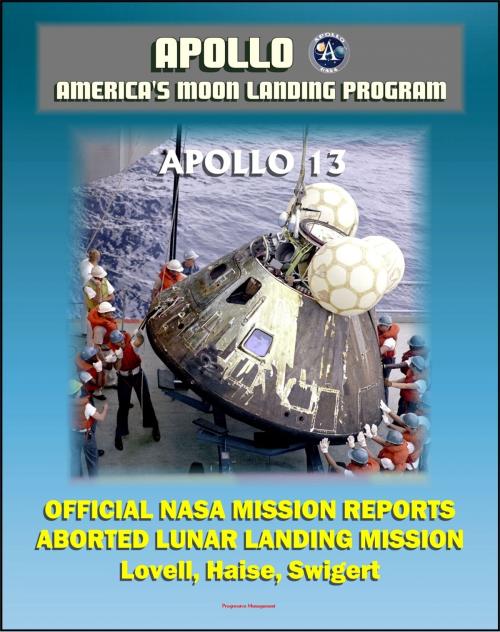Apollo and America's Moon Landing Program: Apollo 13 Official NASA Mission Reports and Press Kit - April 1970 Aborted Third Lunar Landing Attempt "Successful Failure" - Lovell, Haise, and Swigert
Nonfiction, Science & Nature, Science, Physics, Astronomy, History, Americas| Author: | Progressive Management | ISBN: | 9781465922366 |
| Publisher: | Progressive Management | Publication: | November 26, 2011 |
| Imprint: | Smashwords Edition | Language: | English |
| Author: | Progressive Management |
| ISBN: | 9781465922366 |
| Publisher: | Progressive Management |
| Publication: | November 26, 2011 |
| Imprint: | Smashwords Edition |
| Language: | English |
Three comprehensive official NASA documents - converted for accurate flowing-text e-book format reproduction - chronicle the incredible flight of Apollo 13, which returned safely to Earth after aborting its planned lunar landing in April 1970. (Please note that due to space constraints, the Cortright Apollo 13 Review Board report is available as a separate ebook.)
Two technical mission reports, the Manned Spacecraft Center (MSC) Apollo Mission Report and the NASA Headquarters Mission Operation Report (MOR), provide complete details about every aspect of the mission.
Apollo 13 MSC Mission Report: Mission description, pilots' report, communications, trajectory, command and service module performance, mission support performance, assessment of mission objectives, launch vehicle summary, anomaly summary (CSM, LM, government furnished equipment), conclusions, vehicle descriptions. Apollo 13 MOR: Mission design and execution, spacecraft performance, flight anomalies, detailed objectives and experiments, launch countdown, detailed flight mission description, back contamination program, contingency operations, configuration differences, mission support, recovery support plan, flight crew, mission management responsibility, program management, abbreviations and acronyms. Apollo 13 Press Kit: Detailed preview from countdown to landing.
The Apollo 13 mission, planned as a lunar landing in the Fra Mauro area, was aborted because of an abrupt loss of service module cryogenic oxygen associated with a fire in one of the two tanks at approximately 56 hours. The lunar module provided the necessary support to sustain a minimum operational condition for a safe return to earth. A circumlunar profile was executed as the most efficient means of earth return, with the lunar module providing power and life support until transfer to the command module just prior to entry. Although the mission was unsuccessful as planned, a lunar flyby and several scientific experiments were completed. The space vehicle, with a crew of James A. Lovell, Commander; Fred W. Haise, Jr., Lunar Module Pilot; and John L. Swigert , Jr., Command Module Pilot; was launched from Kennedy Space Center, Florida, at 2:13:00 p.m. e.s.t. (19:13:00 G.m.t.) April 11, 1970. Two days before launch, the Command Module Pilot, as a member of the Apollo 13 backup crew, was substituted for his prime crew counterpart, who was exposed and found susceptible to rubella (German measles). During S-II stage boost, an automatic shutdown of the center engine occurred because of a divergent dynamic structural condition associated with that engine. At approximately 56 hours, the pressure in cryogenic oxygen tank 2 began to rise at an abnormally high rate and, within about 100 seconds, the tank abruptly lost pressure. The loss of oxygen and primary power in the service module required an immediate abort of the mission. The crew powered up the lunar module, and the first maneuver following the incident was made with the descent propulsion system to place the spacecraft once again on a free-return trajectory. A second maneuver performed with the descent engine 2 hours after passing pericynthion reduced the transearth transit time and moved the earth landing point from the Indian Ocean to the South Pacific. Two small transearth midcourse corrections were required prior to entry. The lunar module was jettisoned 1 hour before entry. Landing within sight of the recovery ship. The crew were retrieved and aboard the recovery ship within 45 minutes after landing.
Three comprehensive official NASA documents - converted for accurate flowing-text e-book format reproduction - chronicle the incredible flight of Apollo 13, which returned safely to Earth after aborting its planned lunar landing in April 1970. (Please note that due to space constraints, the Cortright Apollo 13 Review Board report is available as a separate ebook.)
Two technical mission reports, the Manned Spacecraft Center (MSC) Apollo Mission Report and the NASA Headquarters Mission Operation Report (MOR), provide complete details about every aspect of the mission.
Apollo 13 MSC Mission Report: Mission description, pilots' report, communications, trajectory, command and service module performance, mission support performance, assessment of mission objectives, launch vehicle summary, anomaly summary (CSM, LM, government furnished equipment), conclusions, vehicle descriptions. Apollo 13 MOR: Mission design and execution, spacecraft performance, flight anomalies, detailed objectives and experiments, launch countdown, detailed flight mission description, back contamination program, contingency operations, configuration differences, mission support, recovery support plan, flight crew, mission management responsibility, program management, abbreviations and acronyms. Apollo 13 Press Kit: Detailed preview from countdown to landing.
The Apollo 13 mission, planned as a lunar landing in the Fra Mauro area, was aborted because of an abrupt loss of service module cryogenic oxygen associated with a fire in one of the two tanks at approximately 56 hours. The lunar module provided the necessary support to sustain a minimum operational condition for a safe return to earth. A circumlunar profile was executed as the most efficient means of earth return, with the lunar module providing power and life support until transfer to the command module just prior to entry. Although the mission was unsuccessful as planned, a lunar flyby and several scientific experiments were completed. The space vehicle, with a crew of James A. Lovell, Commander; Fred W. Haise, Jr., Lunar Module Pilot; and John L. Swigert , Jr., Command Module Pilot; was launched from Kennedy Space Center, Florida, at 2:13:00 p.m. e.s.t. (19:13:00 G.m.t.) April 11, 1970. Two days before launch, the Command Module Pilot, as a member of the Apollo 13 backup crew, was substituted for his prime crew counterpart, who was exposed and found susceptible to rubella (German measles). During S-II stage boost, an automatic shutdown of the center engine occurred because of a divergent dynamic structural condition associated with that engine. At approximately 56 hours, the pressure in cryogenic oxygen tank 2 began to rise at an abnormally high rate and, within about 100 seconds, the tank abruptly lost pressure. The loss of oxygen and primary power in the service module required an immediate abort of the mission. The crew powered up the lunar module, and the first maneuver following the incident was made with the descent propulsion system to place the spacecraft once again on a free-return trajectory. A second maneuver performed with the descent engine 2 hours after passing pericynthion reduced the transearth transit time and moved the earth landing point from the Indian Ocean to the South Pacific. Two small transearth midcourse corrections were required prior to entry. The lunar module was jettisoned 1 hour before entry. Landing within sight of the recovery ship. The crew were retrieved and aboard the recovery ship within 45 minutes after landing.















